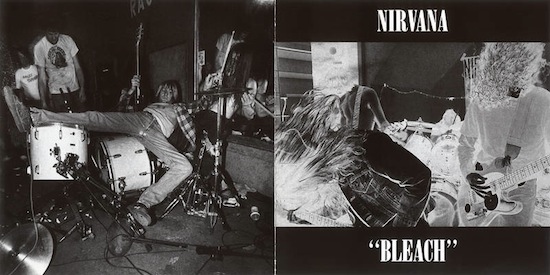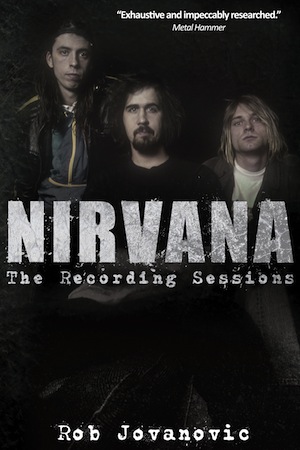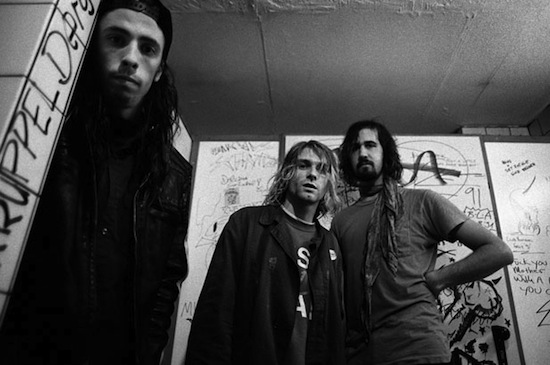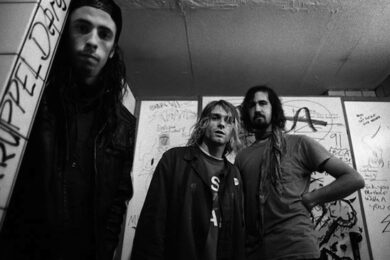Regardless of any personal position – love or hate, or occupy the lithium-addled numbness of the middle ground – Nirvana have been (and remain) a seminal influence on the trajectory of the popular and alternative music that has succeeded their own firebrand grunge.
In this extract, detailing the build up to and recording of the inaugural Bleach, Rob Jovanovic provides us with a brief glimpse at the first instances of a band yet to make their mark; a band called Kurt Kovain.
The sessions for what would become Nirvana’s debut album were spread over a year. When they started they didn’t even have the name ‘Nirvana’ but what they did have was a handful of demos to record and a different drummer. Sub Pop, the label that would give them their break, wasn’t yet a fully operational outfit and they were all pretty much broke. Kurt had saved a small amount of money to pay for the initial session and later in the year, for the final Bleach sessions, they got extra guitarist Jason Everman to foot the bill. He didn’t even play on the album though he was credited as doing so. All sessions for the album took place at Reciprocal Studios in Seattle under the guidance of Jack Endino. Recording Nirvana’s debut releases did his career no harm either.
Kurt was already taking his music seriously and insisted on a number of rehearsals before the January 1988 session. He’d honed a number of songs to record from his quickly growing repertoire. The plan was to record a tape of demos to send to his favorite punk labels like Touch ‘n’ Go and SST. Producer Jack Endino passed on a tape to Sub Pop though, and the rest is history. Dale Crover left to be replaced by Nirvana’s first ‘permanent’ drummer, Chad Channing, and the new trio cut a debut single, “Love Buzz”, in the summer of 1988 – a cover of a song by an obscure Dutch band of all things. Then they reached an agreement with Sub Pop for an album, re-cut some of their songs and had a concentrated effort to finish the album between December 1988 and January 1989. The resultant record, Bleach, led the grunge movement and put Seattle’s burgeoning rock scene firmly on the global map.
This scene had the Sub Pop label at the heart of it. Bruce Pavitt had started his Subterranean Pop fanzine back in 1979 and had produced cassettes to be given away with his publication. This gradually gathered momentum and in April 1988 Pavitt linked up with Jonathan Poneman to launch a ‘real’ label (they had put out quarterly EPs since late 1987) and shortened the title to Sub Pop.

By the time Sub Pop approached Nirvana to work on a single, the band had switched drummers from Dale Crover (who moved to California with the Melvins shortly after session 7) to Dave Foster, briefly back to Aaron Burckhard and then finally to Chad Channing. Nirvana would re-record some of the tracks that Crover had played on, but three of his tracks – “Downer”, “Floyd The Barber” and “Paper Cuts” – would make the album. For some people, especially those that went back to buy it after hearing Nevermind (30,000 copies of Bleach were sold before the follow-up album, almost four million have been sold worldwide since), Bleach was a difficult album to listen to; abrasive, uncompromising and punk-metal, whereas Nevermind was punk-pop. Bleach did have some ‘pop’ moments though, as “About A Girl” and “Love Buzz” proved, but the overriding sound was heavy, sludgey, grungey. It was released in June 1989 with a Sub Pop press release that was meant to be tongue-in-cheek, but turned out to be pretty accurate: “Hypnotic and righteous heaviness from these Olympia pop stars. They’re young, they own their own van and they’re going to make us rich!”
Bleach sold well for a relatively unknown band, and reached the indie Top 10 in the UK before its infinitely more successful follow-up arrived. Nirvana was on the way.
[…]
On January 23, 1988 Kurt Cobain entered a recording studio for the first time shortly before noon. They unloaded their rag-tag assembly of equipment and began setting up. Kurt’s Univox guitar with Univox humbucking pickups, a Randall amp for Dale and Krist’s bass, about which Endino recalls, “the bass cab was a big 2×15 that in the early days was always missing one wheel.”
They were ready to record as many demos as possible in their allotted time. They had booked just six hours to record because of a gig commitment that night in Tacoma and a lack of money, so things had to go smoothly. Although Kurt was nervous and excited, he was also serious about doing things properly. Endino was impressed by their professionalism, as he told the BBC: “They didn’t screw around in the studio, they just wanted to get it done. I mean you don’t record and mix ten songs in one afternoon unless you are very, very focused and they were very focused. Most of the music was done in one take. So that in itself impressed me enough.” They did slip a little though as they had twelve songs ready to go but ran out of time and money. In fact the final song they attempted, “Pen Cap Chew”, cut out part way through because the tape ended and they couldn’t afford the $30 for a new roll.
Starting at noon, each song was done with a run through and then one take, in most cases, and recorded on the 8-track set up. By three in the afternoon the basic recording was done; Endino immediately set about producing a rough mix of the session for the band to take home with them. This must have been a sight to behold as the band tried unsuccessfully to squeeze into the tiny control room which barely held a couple of people at the best of times, especially with the towering Novoselic present. The rough mix was completed shortly before 6 p.m.
The bill came to $152.44: Endino charged them only for five hours of studio time at $20 per hour and $30 for one roll of tape and taxes. Cobain handed over his savings and grasped the tape. Then it was time to head to Tacoma. Tracy Marander remembers Kurt sitting in the van, clutching the tape with a big smile on his face. When the band left, Endino was impressed enough to stay behind and do a second mix for himself – this is the tape that he would later pass on to Sub Pop. “It was Kurt’s singing that stood out,” he says, “He screamed with such passion, just something about his voice was arresting.”

Nirvana: The Recording Sessions is available now on Soundcheck Books



